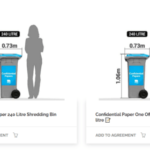Is Making Paper From Leaves Feasible? 🍃
Energy Disrupter
Making Paper From Leaves 🍃: Imagine if companies made paper not from tall trees, but from tiny leaves. Could they really do that on an industrial scale? Of course, we’re here to find out! Let’s talk about whether it is possible for businesses to use lots of leaves to make paper and what that might mean for our world. Join us as we discuss the pros, cons and exciting possibilities of changing how we make paper in a more nature-friendly way.
Plenty of you, just like us here at Waster, wish to have more awareness of how to sustainably use resources and value them by utilising them to their utmost potential. However, even the best of us at times fail to account for how many resources we consume daily.
>Download Now: Free PDF Business Owners Guide To Commingled Recycling Bin Services
Paper, in particular, is one, if not the most, produced and used global resource.
Again, producing excessive paper globally has harmful effects. It leads to deforestation, emits greenhouse gases and uses a significant amount of water. This harms ecosystems, disrupts habitats and worsens air and water quality.
It also creates waste and contributes to landfill problems. Furthermore, it can negatively affect communities and increase resource depletion. To address these issues, we need more sustainable paper production methods, recycling and reducing paper use overall.
One sustainable method to produce paper, in theory, is by making paper from leaves instead of tree-based pulp. But how feasible is this on a more industrial scale? Can we maybe see businesses in the near future use leaves as a substitute to create paper? Let us talk about it more below.
Can businesses make paper by using leaves?
It is not all black and white when it comes to determining whether or not we can make paper by using leaves.
Using fallen leaves as a primary source for paper production in the future is an intriguing concept with both potential benefits and challenges. So, here’s an assessment of the idea:
Potential benefits of making paper from leaves:
- Environmental Sustainability: Utilising fallen leaves could reduce the demand for virgin wood pulp, which is currently the primary source of paper production. This could help protect forests and ecosystems by decreasing the need for tree harvesting.
- Reduced Waste: Fallen leaves are often considered waste and are disposed of through various means. Using them for paper production could contribute to waste reduction and promote a more circular economy.
- Lower Carbon Footprint: Fallen leaves are readily available annually, and their use as a renewable resource could have a lower carbon footprint compared to the long growth cycles of trees used for paper production.
- Local Sourcing: Leaves are generally found locally, reducing the need for long transportation distances and potentially supporting local economies and communities.
The challenges:
- Leaf Availability and Collection: Whilst fallen leaves are abundant, collecting and processing them on a large scale might pose logistical challenges. Developing efficient and cost-effective collection methods would be essential.
- Quality and Consistency: The quality and fibre content of leaves may vary depending on factors such as tree species, location, and season. Ensuring consistent paper quality could be a challenge.
- Processing Technology: Developing or adapting processing technologies to efficiently convert leaves into high-quality paper might require innovation and investment.
- Economic Viability: The cost-effectiveness of collecting, processing, and converting fallen leaves into paper would need to be competitive with existing paper production methods.
- Market Demand and Acceptance: Businesses would need to gauge market demand for leaf-based paper products and ensure that consumers are willing to accept potential differences in texture, colour and other characteristics.
Take a look at Releaf Technology
Obviously, not a lot of companies have invested time and money to make paper products from leaves because of the said challenges above. However, we have one example of a company that now found a way to change the landscape of the paper-making industry.
Just last year, the company Releaf announced a new technology that turns fallen leaves into paper.
“Releaf’s patented technology extracts cellulose fibres from leaves collected from urban areas rather than forests, which forms the basis of its recyclable and decomposable paper products. The specific properties of leaf fibres also enable Releaf to produce paper with a lower carbon footprint and water consumption than mainstream processes.”
Releaf technology presents a groundbreaking approach to paper production. They do so by utilising renewable raw materials whilst eliminating the need for chemicals and achieving an impressive 78 per cent reduction in CO2 emissions.
By exclusively utilizing fallen leaves and recycled fibres, they create top-tier paper that boasts qualities comparable to traditional paper, without any compromise in performance or characteristics.
Waster’s final thoughts
In the future, using fallen leaves for paper production offers significant environmental benefits alongside challenges. By reducing reliance on virgin wood pulp – the current mainstay – this approach could safeguard forests and ecosystems while repurposing discarded leaves to address waste issues.
Another advantage is the lower carbon footprint of fallen leaves, which are annually abundant and have a quicker growth cycle than traditional paper trees. Moreover, local leaf sourcing may boost economies.
Yet, practical implementation faces hurdles. Efficient large-scale leaf collection and processing methods are vital for viability. Ensuring consistent paper quality is complex due to variations in factors like tree species and location.
Developing processing technologies for high-quality paper from leaves requires innovation and investment. Economic feasibility hinges on competitive costs against existing paper production. Market demand and consumer acceptance of leaf-based paper also warrant assessment.
In conclusion, the potential of fallen leaves as a primary paper source is promising for environmental sustainability. Realizing this vision requires overcoming challenges through innovative solutions, sustainable collection practices, and consumer support.
Tech, markets, and eco-care will determine if it’s a green choice for businesses.
Contact Waster right now for your waste and recycling needs now!
Does your Australian-based business need waste and recycling services? If so, then you have come to the right website!
Please call 1300 WASTER (1300 927 837). You can also email us at [email protected] or [email protected] if you have further questions. Find the best deals in terms of waste and recycling pricing and services!

















